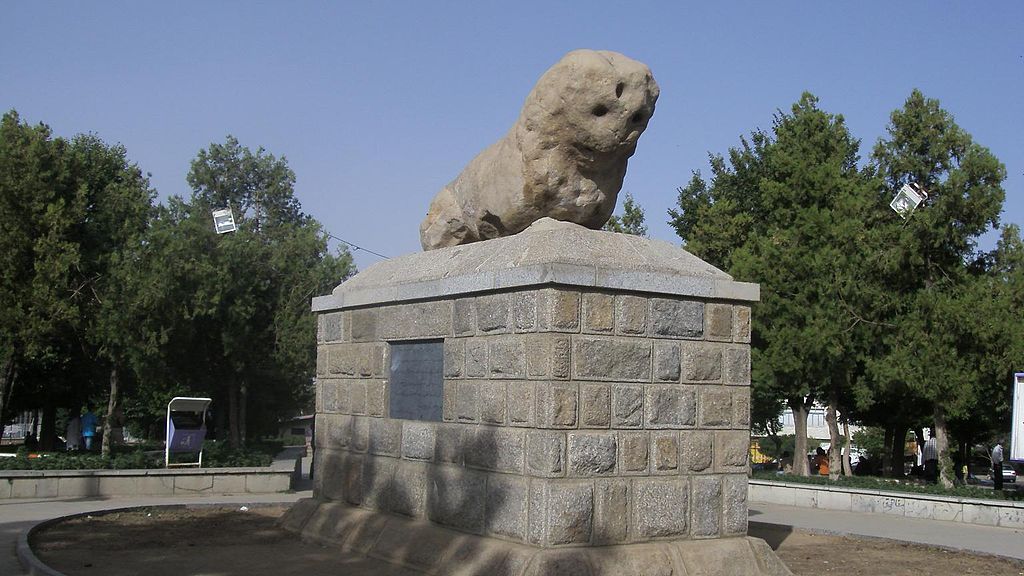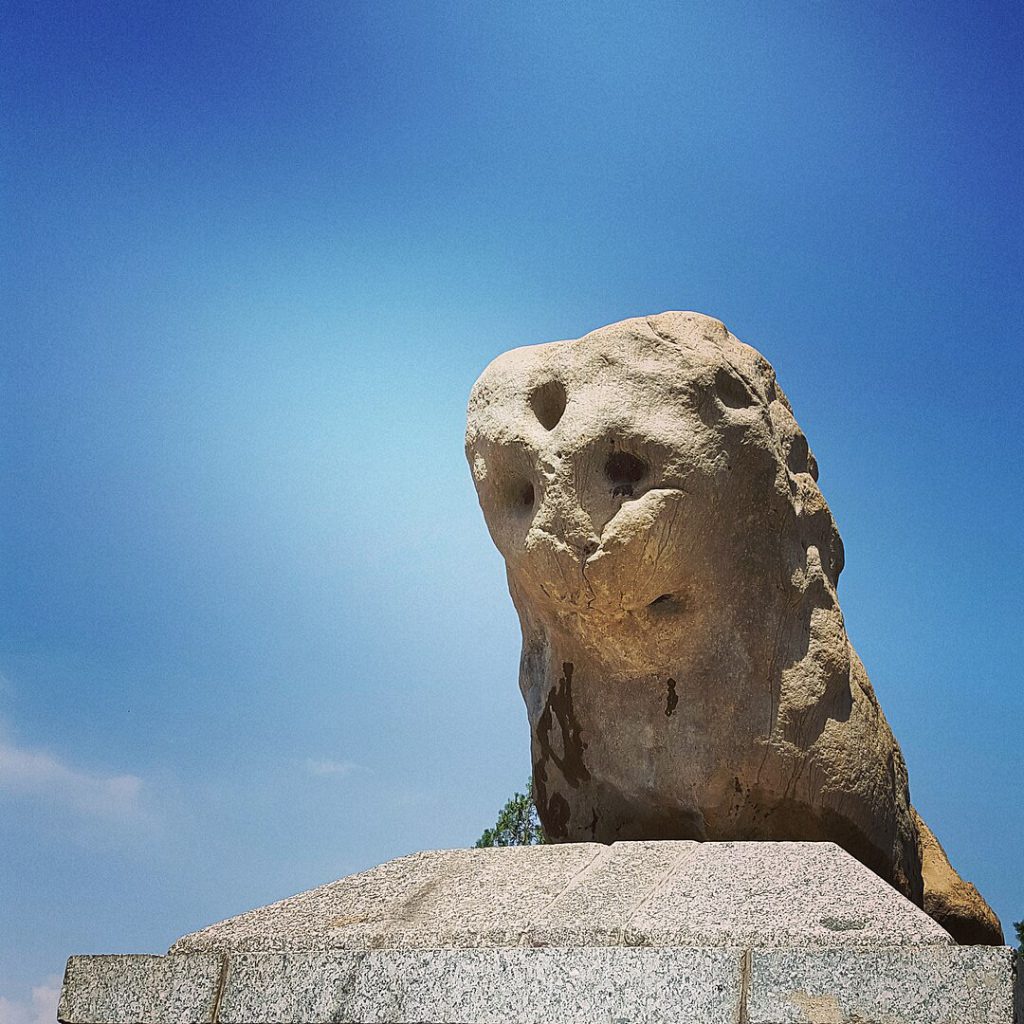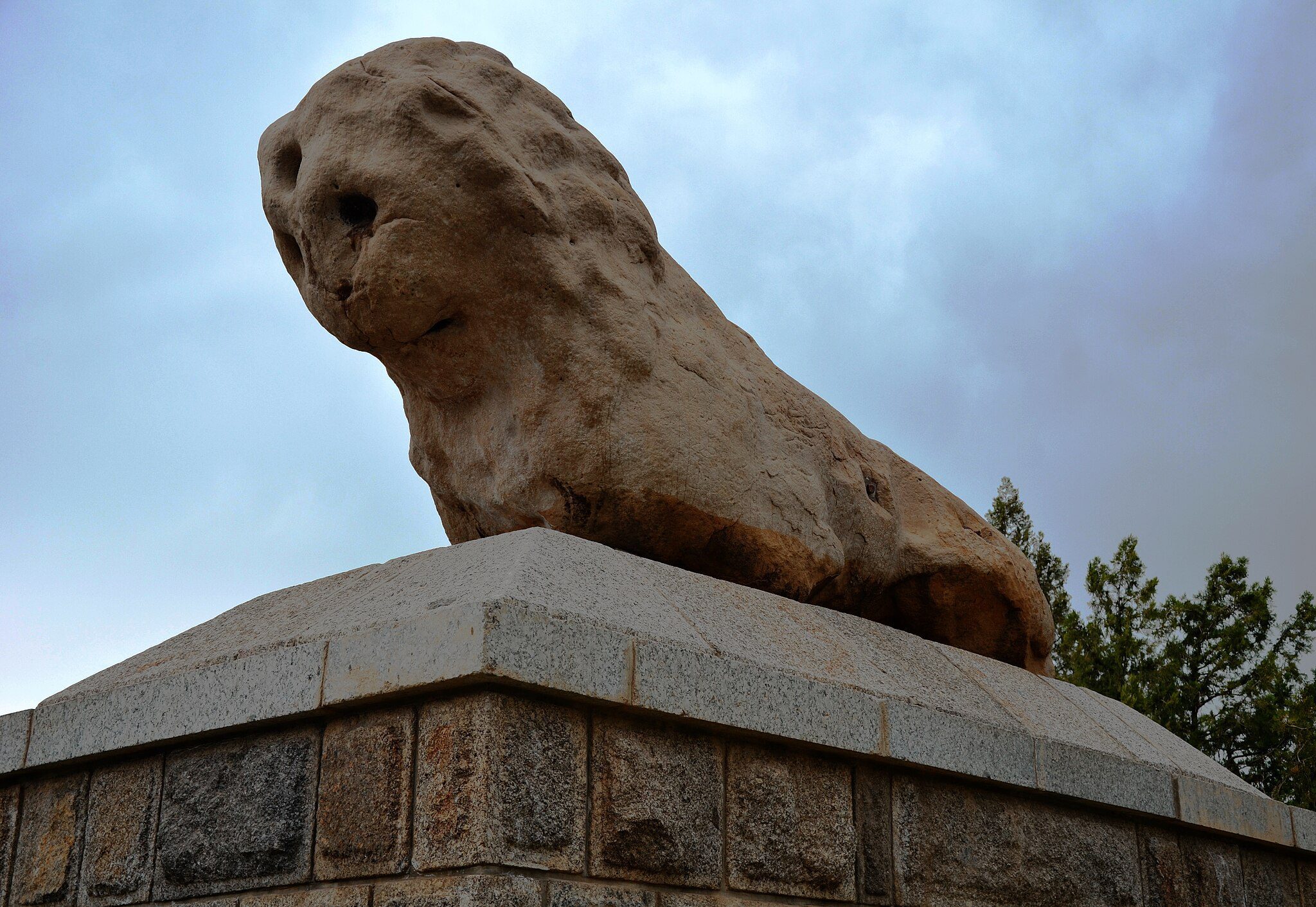Table of Contents
Nestled in the heart of Hamedan, Iran, the Stone Lion, known as Shir’e Sangi in the local tongue, stands as a captivating testament to the city’s rich history. This enigmatic monument, situated on a hill believed to have housed a Parthian cemetery, has intrigued scholars and locals for centuries. With its battered yet majestic figure, the Stone Lion holds a cherished place in the hearts of the people, shrouded in mysteries that have sparked countless theories about its origin.
Once forming part of the imposing Lion’s Gate, the Stone Lion and its twin companion served as the ancient gateway to the city. However, the gates met their demise in 931 CE when the Daylamids overtook Hamedan. Today, the Stone Lion resides in the serene park and square of Sang Shir, commanding reverence from all who encounter it. Crafted from yellow sandstone, this stoic sculpture measures an impressive 2.5 meters in length, 1.15 meters in width, and 2.2 meters in height at its front, representing a legless and weathered lion.

As for its history, there are conflicting theories surrounding the origins of the Stone Lion. Some accounts trace its roots back to the Medes, the first Iranian dynasty, while others attribute it to the Parthian era, given its discovery atop a mound that once served as a Parthian cemetery. Adding to the intrigue, Iran’s Cultural Heritage Organization suggests that the statue was originally constructed at the behest of Alexander the Great, commemorating the untimely death of his loyal companion, Hephaestion.
The Stone Lion stands not only as a magnificent work of art but also as a gateway to unraveling the secrets of Hamedan’s past. Its weathered features and silent majesty inspire wonder and curiosity, leaving us captivated by the stories etched into its ancient stone. As visitors and locals alike stand in its presence, the Stone Lion beckons us to contemplate the echoes of history and to appreciate the enduring legacy it represents.
Mapping the Marvels and Sections of The Stone Lion
Nestled atop a hill, the Lion Stone in Hamadan stands as a testament to the city’s rich historical tapestry. This ancient artifact has captivated visitors for centuries, its origins intertwined with fascinating tales of conquest and preservation. Beyond its formidable presence, the hill itself holds a secret—a coffin from the Parthian period emerged from its depths, now safeguarded within the hallowed halls of the Hegmatane Museum.

Centuries ago, as the city of Hamadan took shape, the Lion Stone proudly guarded its entrance. Known as Bab al-Asad, or the Gate of the Lion of Diliman, it beckoned travelers and warriors alike. However, when the Arabs conquered Hamedan in 319 AD, the once-majestic city gate met a tragic fate, reduced to ruins by the ravages of war. In the aftermath, Mardavij, seeking to relocate the stone lions to Ray, faced failure and instead resorted to desecrating one of these magnificent statues, shattering the paw of another.
For years, the damaged lion lay abandoned, its spirit diminished, until a turning point in 1328. It was then that the talented engineer Sihun, renowned for crafting the splendid tomb of Abu Ali Sina, breathed new life into the wounded sentinel. With unwavering dedication, he painstakingly restored the lion to its former glory, granting it a new purpose and a place of honor in its present location.
Intriguing and resilient, the Lion Stone of Hamadan continues to enthrall visitors with its storied past. As you stand before this majestic guardian, allow yourself to be transported back in time, envisioning the city gate it once protected and the legends it embodies.Top of Form
Unveiling The Stone Lion: Choose Your Path
In the quest to uncover the wonders of The Stone Lion, you have two distinct paths to embark upon: the vibrant world of public transportation or the liberating freedom of private cars. Each option holds its own allure, promising a unique journey filled with captivating experiences and breathtaking encounters.
Public transportation immerses you in the beating heart of the city, where the symphony of sights, sounds, and scents paints a vivid backdrop for your adventure. Embrace chance encounters and unexpected detours as you navigate the labyrinthine network, discovering hidden gems along the way. From bustling markets to charming cafés, the journey to The Stone Lion is a tapestry of everyday life, building anticipation with every passing moment.
On the other hand, private cars offer a taste of freedom and exploration. The open road becomes your canvas as you chart your own course, deviating from the beaten path and venturing into picturesque landscapes. With the wind in your hair and the hum of the engine as your companion, you experience the thrill of discovery at every turn. As the sun sets and The Stone Lion comes into view, you arrive knowing that the journey was just as magical as the destination itself.
Whether you choose the vibrant rhythm of public transportation or the freedom of private cars, The Stone Lion awaits, ready to envelop you in its timeless embrace. Set forth on your chosen path and uncover the wonders that await, for this enchanting destination promises unforgettable moments at every step.
FAQs about the Stone Lion
Q1: What is the historical significance of the Stone Lion in Hamadan?
A1: The Stone Lion in Hamadan holds great historical significance as it served as an ancient gateway to the city. It was part of the Lion’s Gate, which was unfortunately destroyed in 931 CE. The monument stands as a testament to the rich history of Hamadan and has sparked various theories about its origin.
Q2: What are the dimensions of the Stone Lion in Hamadan?
A2: The Stone Lion in Hamadan is an impressive sculpture crafted from yellow sandstone. It measures approximately 2.5 meters in length, 1.15 meters in width, and 2.2 meters in height at its front. The monument represents a legless and weathered lion.
Q3: What are the conflicting theories about the origin of the Stone Lion?
A3: There are conflicting theories regarding the origin of the Stone Lion. Some accounts trace its roots back to the Medes, the first Iranian dynasty, while others attribute it to the Parthian era due to its discovery atop a mound believed to have been a Parthian cemetery. Additionally, the Iran’s Cultural Heritage Organization suggests that the statue was originally commissioned by Alexander the Great to commemorate the death of his loyal companion, Hephaestion.
Q4: What is the history of the damaged lion and its restoration?
A4: The damaged lion was originally part of the Lion’s Gate in Hamadan. However, it was desecrated during the 10th century by Mardavij, resulting in one of its paws being shattered. In 1328, the talented engineer Sihun restored the wounded sentinel to its former glory, breathing new life into the monument and granting it a place of honor in its current location.
Q5: How can one explore The Lion Skin of Hamadan during a visit to Iran?
A5: To explore The Lion Skin of Hamadan and other attractions in Iran, it is recommended to embark on a customized tour. Companies like ToIranTour offer professional Iran tours and travel packages that can be tailored to individual interests. Their experienced travel experts can design personalized itineraries that highlight the best of Iran’s cultural, historical, and natural attractions, ensuring a memorable experience.
Customized Tours to Iran: Experience the Best of The Lion Skin of Hamadan
If you’re planning to travel to Iran and have a keen interest in exploring The Lion Skin of Hamadan, embarking on a customized and tailored tour is the perfect way to ensure you make the most of your experience. With its rich history, cultural significance, and breathtaking beauty, Iran offers a plethora of unique attractions for travelers to discover.
When it comes to exploring The Lion Skin of Hamadan, one of Iran’s most iconic treasures, it is essential to have a well-crafted itinerary that caters to your specific interests and preferences. This is where ToIranTour comes in, offering professional Iran tours and travel packages designed to suit the needs of every traveler.
At ToIranTour, we understand that each traveler has their own unique preferences and expectations when it comes to exploring a new destination. That’s why we take pride in crafting customized tours that cater to your specific interests, including an in-depth exploration of The Lion Skin of Hamadan.
Our team of experienced travel experts specializes in designing personalized itineraries that highlight the best of Iran’s cultural, historical, and natural attractions, ensuring you have a truly memorable experience. Whether you’re interested in exploring ancient ruins, immersing yourself in local traditions, or indulging in mouthwatering Persian cuisine, our tailored tours can be customized to your desires.
With ToIranTour, you can rest assured that your journey to The Lion Skin of Hamadan will be carefully planned, offering you the opportunity to delve into its fascinating history and marvel at its architectural splendor. Our knowledgeable guides will accompany you throughout your tour, providing valuable insights and ensuring you don’t miss any hidden gems.
We are here to help you have a great experience in Iran, and our commitment to customer satisfaction is unmatched. By choosing our Iran tours, you can relax and focus on enjoying your trip, knowing that every detail has been taken care of.
Embark on a customized tour with ToIranTour, and let us create an unforgettable journey for you. Experience the best of The Lion Skin of Hamadan and discover the wonders of Iran in a way that perfectly suits your preferences.

